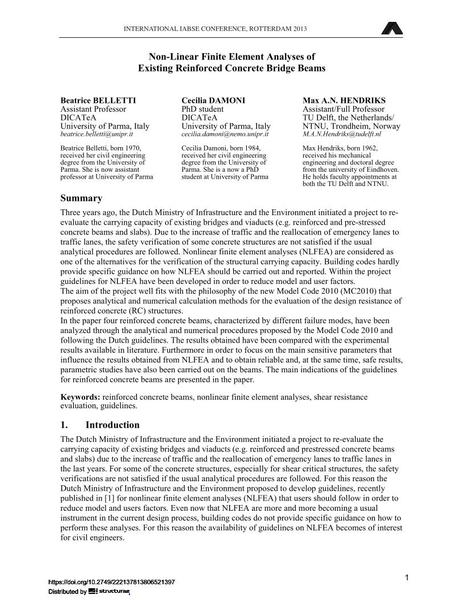Non-Linear Finite Element Analyses of Existing Reinforced Concrete Bridge Beams

|
|
|||||||||||
Bibliographic Details
| Author(s): |
Beatrice Belletti
Cecilia Damoni Max A. N. Hendriks |
||||
|---|---|---|---|---|---|
| Medium: | conference paper | ||||
| Language(s): | English | ||||
| Conference: | IABSE Conference: Assessment, Upgrading and Refurbishment of Infrastructures, Rotterdam, The Netherlands, 6-8 May 2013 | ||||
| Published in: | IABSE Conference, Rotterdam, May 2013 | ||||
|
|||||
| Page(s): | 520-521 | ||||
| Total no. of pages: | 8 | ||||
| Year: | 2013 | ||||
| DOI: | 10.2749/222137813806521397 | ||||
| Abstract: |
Three years ago, the Dutch Ministry of Infrastructure and the Environment initiated a project to re- evaluate the carrying capacity of existing bridges and viaducts (e.g. reinforced and pre-stressed concrete beams and slabs). Due to the increase of traffic and the reallocation of emergency lanes to traffic lanes, the safety verification of some concrete structures are not satisfied if the usual analytical procedures are followed. Nonlinear finite element analyses (NLFEA) are considered as one of the alternatives for the verification of the structural carrying capacity. Building codes hardly provide specific guidance on how NLFEA should be carried out and reported. Within the project guidelines for NLFEA have been developed in order to reduce model and user factors. The aim of the project well fits with the philosophy of the new Model Code 2010 (MC2010) that proposes analytical and numerical calculation methods for the evaluation of the design resistance of reinforced concrete (RC) structures. In the paper four reinforced concrete beams, characterized by different failure modes, have been analyzed through the analytical and numerical procedures proposed by the Model Code 2010 and following the Dutch guidelines. The results obtained have been compared with the experimental results available in literature. Furthermore in order to focus on the main sensitive parameters that influence the results obtained from NLFEA and to obtain reliable and, at the same time, safe results, parametric studies have also been carried out on the beams. The main indications of the guidelines for reinforced concrete beams are presented in the paper. |
||||
| Keywords: |
guidelines non-linear finite element analysis shear resistance evaluation reinforced concrete beams
|
||||
